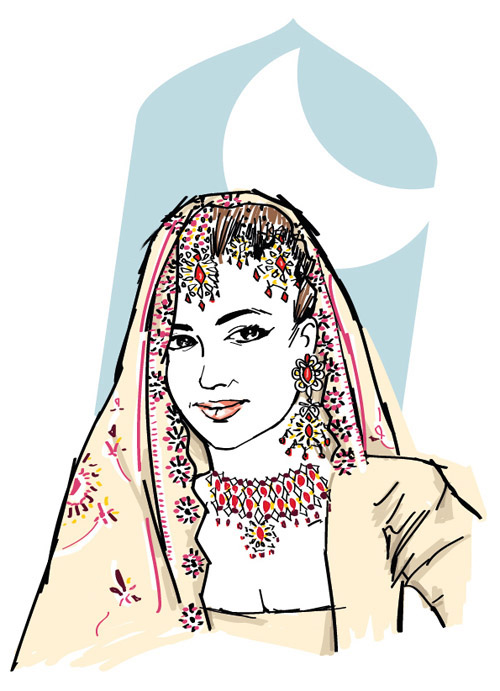
An account from Wikipedia:
Mah Laqa Bai was born as Chanda Bibi on 7 April 1768 in Aurangabad in the present-day Maharashtra.[1][2]:120 Her mother was Raj Kunwar – a courtesan who migrated from Rajputana,[3] and father was Bahadur Khan, who served as aMansabdar (military official) at Mughal Emperor Muhammad Shah‘s court. Khan migrated from Delhi to Hyderabad Deccan where he met and married Raj Kunwar.[4]:107 Chanda Bibi was adopted by Kunwar’s childless sister Mehtaab Ma who was married to Nawab Rukn-ud-Daula, a Prime Minister of Nizam of Hyderabad.[5]
Chanda Bibi’s adoptive father took personal interest in her education and provided her with the best teachers. While growing up, she had access to a well-endowed library and was exposed to the vibrant culture of Hyderabad. By the time she was 14, she excelled in horse riding and archery. Due to her skills, she accompanied the Nizam II (Mir Nizam Ali Khan) in three wars;[6] dressed in male attire, she was noted for bow and javelin skills in the wars. Owing to her contributions, the Nizams awarded her with Jagir (lands) on various occasions,[4]:81 & 124[7]:172-3[8]:355-6 that include the neighborhoods of Hyderguda, Chanda Nagar, Syed pally and Adikmet.[9] On one occasion, she was conferred the title of Mah Laqa — meaning “Visage of the Moon”. Though she never married, she was in love with Raja Rao Rambha Rao (a Maratha military chief who led a cavalry of 600 army men, fought against Maratha Empire under the second Nizam and became his favourite), and used to admire Captain Sir John Malcolm (an assistant of James Achilles Kirkpatrick, the British Resident at Hyderabad).[4]:81 & 124[7]:172-3[8]:355-6[10]
She was an influential woman in the court of the second and third Nizam of Hyderabad.[11]:365-85 At that time, she was the only woman to be given recognition publicly in Hyderabad State. In addition, she was appointed to the omarah, the highest nobility. Mah Laqa was frequently consulted by the rulers of the state on policy matters.[4]:81 As a pride among the nobility in those times, a battalion of 500 soldiers was reserved to march with her while she visits any official.[12] She was also acourtesan while the Nizams held court.[13] She was a mistress of the Prime Ministers of the Nizams.[11] She died in 1824 and bequeathed her properties that included land, gold, silver and diamond-studded jewelery to homeless women.[2] Her residence which was located in Nampally, Hyderabad, today had been converted into a Government aided girls degree college.[9] Mah Laqa of Deccan was the contemporary of renowned poets like Mir Taqi Mir, Mirza Muhammad Rafi Sauda andKhwaja Mir Dard in North India.[14]
Mah Laqa was influenced by the literary work of mystic poet Siraj Aurangabadi (1715–1763),[2]:121[15]:4109 and learned poetry from Nawab Mir Alam who later became the Prime Minister of Hyderabad State. Her first language was Urdu, and she was also fluent in Arabic, Persian and Bhojpurilanguages.[4]:118 & 123 She was the first woman poet to author a diwan, a complete collection of Urdu ghazals. The collection, named Gulzar-e-Mahlaqa, comprises 39 ghazals, and each ghazal consists of 5 couplets. The collection was published in 1824 after her death. [2]:121-2[16] TheDiwan e Chanda is a manuscript collection of Mah Laqa’s 125 Ghazals, compiled and calligraphed by her in 1798. It was signed and gifted to Captain Malcolm on 18 October 1799, during a dance performance at Mir Alam’s residence. It is now preserved in the British Museum.[17][18]:521-2
Her Nom de plume was Chanda. The Urdu words Bulbul (songbird), Gul (rosebud) and Saqi (one who serves wine) recurred as themes in her ghazals.[2]:121-2[16] Her popularity in reading poetry made her the first poetess of the region to participate and present her poetries in a mushaira (poetic symposium) which was earlier reserved for men. Along with her poetry, sometimes she sang the songs composed by the Mughal Emperor Muhammad Shah and Sultan of Bijapur Ibrahim Adil Shah II.[4]:81 & 129 From her Diwan of 39 Ghazal collection, one Ghazal “Hoping to blossom (one day) into a flower” translates as:
|
Hoping to blossom (one day) into a flower, Between the fear of the fowler and (approaching) autumn, Thy sly glance is more murderous than arrow or sword; How can I liken a candle to thy (glowing) cheek? How can Chanda be dry lipped. O Saqi of the heavenly wine! |
Mah Laqa learned singing and classical Indian music Thumri from Khush hal Khan, a master musician of that time,[19]:16 and a great-grandson of the Tansen, the maestro of Mughal court. She excelled in Ghazal singing in multipleraga (melodic modes) and Taal (rhythms); she was adept at the Yaman raga and Khayal Tappa which she use to sing at special occasions. Mah laqa preferred using Bhimpalasi raga in romantic Ghazals. When singing Sufi songs she used Dhrupad raga mixed with taal chautala and raga Bhairavi.[4]:118 & 128 Mah Laqa excelled in singing love lyrics accompanied by Deccani style of Kathak dance.[20][21] She established a cultural centre in which 300 girls were trained by her along with other masters.[5] Maha Laqa’s library contain manuscripts and books on poetry along with the arts and the science collections.[22] She sponsored and supervised the publication of Mahnama, a historical book about the revival period of Hyderabad State. Although Mah Laqa practiced Islam, she was influenced by the understanding of Hindu books and philosophy. One author studied her writings and said that “her verses had a distinct darbari ring in which she eulogized the king and nobles, a common style employed by poets during the 17th and 18th centuries.”[4]:81 & 122
:
